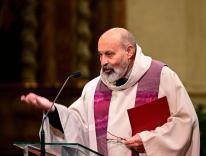
What do women want from the Church? That’s a good and important question. And an international gathering of women this past Tuesday at the Vatican could have been a place to find some honest answers.
But, unfortunately, one had the impression that the discussions were hampered by the strictures of self-censorship; that is, the careful avoidance of saying anything that could be taken by the hierarchy as women demanding too much from churchmen who have been willing to give only too little.
The event was the third annual “Voices of Faith,” sponsored by the Fidel Götz Foundation. It took place in the regal setting of the Casina Pio IV, a patrician villa inside the Vatican Gardens that houses the Pontifical Academy of Sciences.
During the first couple of hours of the afternoon program, women from various walks of life shared moving stories of how their faith has helped them overcome abuse, poverty, blindness, and the ravages of war or how it has given them vision and strength to help others with their own adversities.
This was all very good, as were the various musical interludes. And many of us were hoping that it would be but an appetizer for a much richer fare in the second part of the program—a panel discussion on “expanding women’s leadership in the Church.”
But this is where it became disappointingly clear that these women were muzzling themselves. And what was most disappointing was that these are not people who believe a woman’s place is in the home or her duty is to be submissive to men.
Just to give you an idea, one of the panelists was the president and CEO of Catholic Relief Services and another was a 24-year-old graduate student at Yale. These are bright and successful women, but they—like all the other participants that took to the microphone—were being respectful and gracious to a fault.
One after another thanked Pope Francis for his “inspiration.” They could hardly thank him for his support of Voices of Faith, because in the three years the event has taken place in his backyard he has not once publicly acknowledged it. And this year he went out of town for a weeklong retreat two days before it took place.
The women attentively steered clear of the O-word—that is, ordination—except for one of them to explicitly say that women’s priesthood was “off the table.” Surprisingly, there was not even a mention of the possibility of ordaining women deacons, which is something bishops themselves are beginning to talk about. And no one brought up the issue of women being allowed to preach, even during Mass, which was advocated recently in the pages of L’Osservatore Romano.
Regrettably, one participant repeated the current pope’s refrain about the danger of “clericalizing” women if the church were to ordain them. No one pointed out that ordination should be about sanctioning or deputing servant leaders and not clericalists.
But many of them did acknowledge—at least privately and during the break—that the Catholic Church has a huge problem with attracting and retaining young women among its members. And while they admire Pope Francis for so much of what he has done since he became Bishop of Rome, they feel he could and should do so much more in expanding the role of women at all levels of decision-making and service in the Church. Again, many of those gathered inside the Vatican Gardens said this only quietly and off the record.
****
Another area where the Jesuit pope seems to have made little headway during his first three years in office is in significantly changing the complexion of the worldwide episcopate. His appointments have been a mixed bag.
For every new bishop that comes from the front lines of pastoral work and has the “smell of the sheep,” there are probably ten others who have served only a few years in a parish and are being advanced up the career ladder from a chancery office or some other elite posting.
One of the reasons for this is that the pope must rely on a process for selecting bishops that is still very much in the grips of an incestuous, self-perpetuating “old boys network.” Evidence is this week’s choice of Msgr. James Checchio as the new Bishop of Metuchen in northern New Jersey.
The forty-nine year old monsignor, a priest of the southern New Jersey diocese of Camden, has been living in Rome for the past thirteen years. He was first vice-rector (2003-2006) and then rector of the Pontifical North American College (NAC). That is the same residence for U.S. seminarians studying in the Eternal City where he lived another five years in preparation for priesthood.
His appointment to the episcopate comes as no surprise, given that the college has long been known as a “bishop factory.” More than half of the thirty-three metropolitan archbishops in the United States (including those from the Archdiocese for the Military) are alumni of the NAC or its Casa Santa Maria residences for priests doing advanced studies in Rome. That includes seven of the eight U.S. cardinals who are still under the age of the eighty, the only exception being Cardinal Seán O’Malley, a Capuchin friar.
Bishops and cardinals are a constant presence at the North American College, which sits imposingly on the Janiculum Hill and has a commanding view of Rome and the Vatican. And so are wealthy benefactors of the U.S. Conference of Catholic Bishops, which owns and operates what some refer to as “the West Point of American seminaries.”
Consider also that the two American members of the Congregation for Bishops—Cardinals Donald Wuerl and William Levada—are NAC alumni. And the Australian member of the office that helps choose bishops, Cardinal George Pell, has been sending students to the NAC since the 1990s when he was Archbishop of Melbourne.
Furthermore, two other U.S. cardinals are also former rectors—Edwin O’Brien of the Knights of the Holy Sepulcher (1990-1994) and New York’s Timothy Dolan (1994-2001). So it was only a matter of time before Msgr. Checchio, who has overseen extensive renovations and additions to the college, as well as increased enrollment, was to be brought into the same episcopal club.
Meanwhile, there are three dioceses in the United States that have been without a bishop for several months. Most important among them is the Archdiocese of St. Paul and Minneapolis, which has been vacant since last June. And the ordinaries of eight other American sees (two of them archdioceses) have reached retirement age, as has the apostolic nuncio, Archbishop Carlo Maria Viganò.
The natives are getting restless. Probably the nativists, too…
****
Pope Francis has a tricky relationship with his brother bishops. Selecting new members of the hierarchy is one thing. Gaining the support of those already in place is quite another.
Most bishops in the United States, for example, still display a sort of ambivalence toward the pope. Only a handful of them (comparatively, that is) are quite enthusiastic about the simpler style he models and the pastoral priorities he has set forth. And there are still a good number who constantly quote his predecessors, Benedict XVI or John Paul II, rather than him.
Just south of the border in Mexico a similar dynamic has been seen among the bishops. A number of the mitered did not take kindly to the cautionary words that Francis issued to their episcopal conference last month when he was in the country. He told them not to live like princes and not to talk behind each other’s backs. “If you must fight amongst yourselves, be men and do it face to face,” was the upshot of one admonition.
Sources in Latin America’s most Catholic country said a number of the bishops were hotter than a jalapeño over the pope’s not-so-veiled criticism of them.
Perhaps none was more steamed than the Archbishop of Mexico City, Cardinal Norberto Rivera Carrera, who looked depressed during all five days that he accompanied Francis on his visit. After counting to ten numerous times, he obviously could not keep his cool any longer. Several days ago he authorized (some believe he even wrote) an article in his archdiocesan newspaper that many saw as a sharp rebuke of Francis.
Naturally, the cardinal (who turns seventy-five in June 2017) used churchman double-speak and did not blame the pope directly. He blamed others, facetiously complaining that they had badly misinformed Francis about the bishops in Mexico. Sorry, nobody fell for that one. If there’s a pope who knows what’s going in Latin America and one who knows its bishops very well, it’s this pope from Argentina!
Bishops in the Americas aren’t the only ones who have had difficulty adjusting to Papa Bergoglio.
Spain has a few birds that are not so happy with him either. A good example is the Archbishop-emeritus of Madrid, Cardinal Antonio María Rouco Varela. He was pretty upset when the pope accepted his resignation on his seventy-eighth birthday in August 2014. And he was not pleased when Francis replaced him in Madrid with Carlos Osoro Sierra, who had been Archbishop of Valencia the previous five years. The cardinal, who was a great ally of Benedict XVI in the culture war against liberal society, had hoped for a different successor (probably in both Madrid and Rome).
In the end he went quietly enough. But now, more than a year-and-a-half later, he’s making a bold statement by announcing that he will lead a major pilgrimage in June. No, it’s not to Rome for the Holy Year of Mercy. And it’s not to the Holy Land, either.
According to an email sent out from Itinera Tours, a religious tour company in Spain, Cardinal Rouco will lead “a special pilgrimage to the most important places connected to the childhood and a early life of Joseph Aloisius Ratzinger, one of the most important intellectuals of our time.”
The June 5-11 pilgrimage will go to Munich and ten other Bavarian towns and villages to see the sites where “one of the most outstanding personalities of the Catholic Church” carried out his “academic career, his ordination as priest, archbishop and cardinal”.
Just for the record, the University of Tübingen is not part of the itinerary.


